Your cart is currently empty!
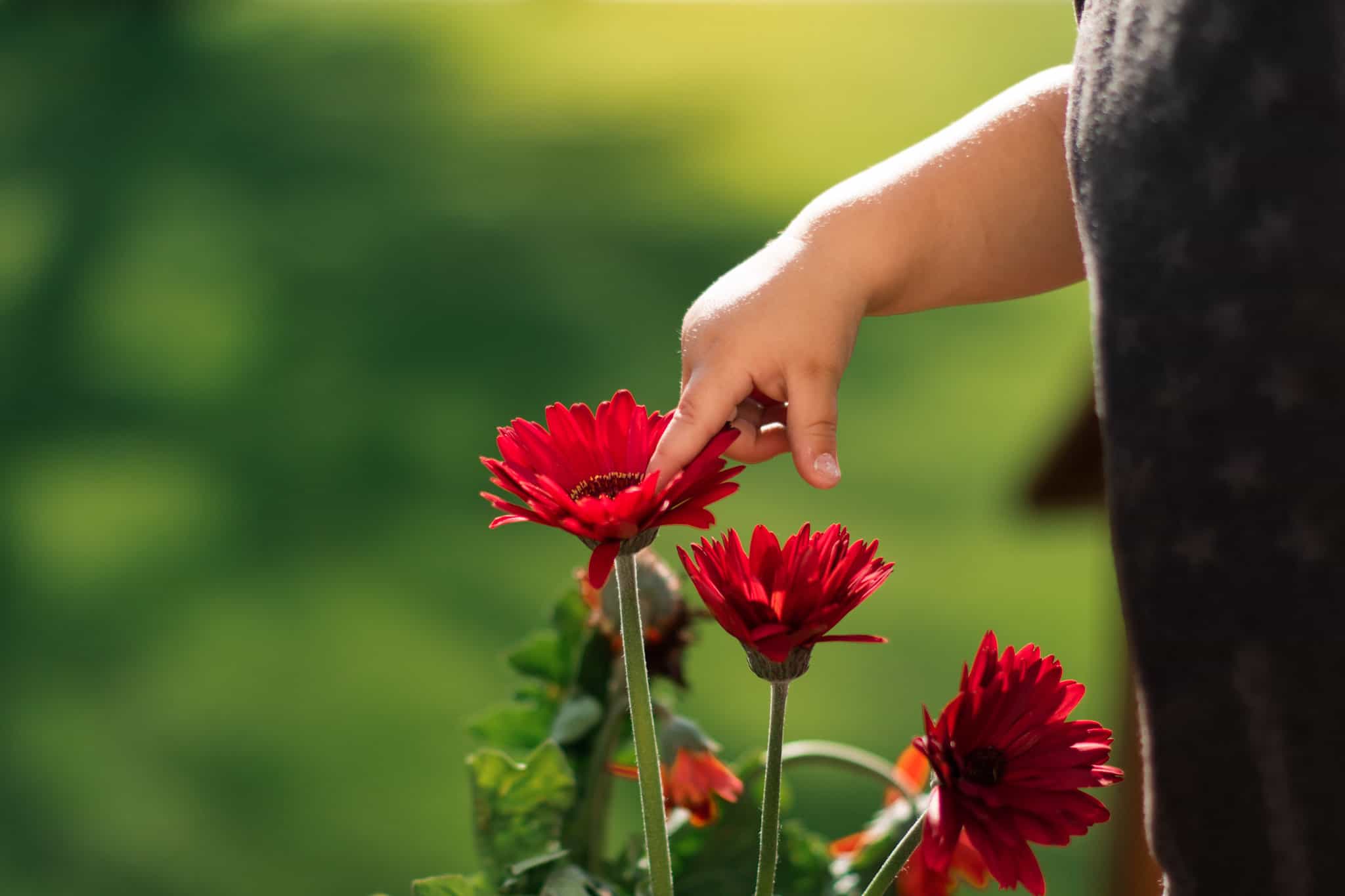
How to Start & Grow a Cut Flower Garden with Kids
If you enjoy bringing the outside in, gathering a few flowers from your garden to admire on the kitchen table, gifting bouquets to friends, or using in nature crafts and projects, then consider starting a small cut flower garden. Tending these plants from the smallest of seeds into colorful beauties brings a wonderful sense of accomplishment and joy. Plus, gardening has so many amazing benefits for both kids and parents. Today, Illinois mom of three, Meghan Garriott, is here sharing everything you need to know about planting and growing a cut flower garden with kids and the harvesting and arranging of flowers.
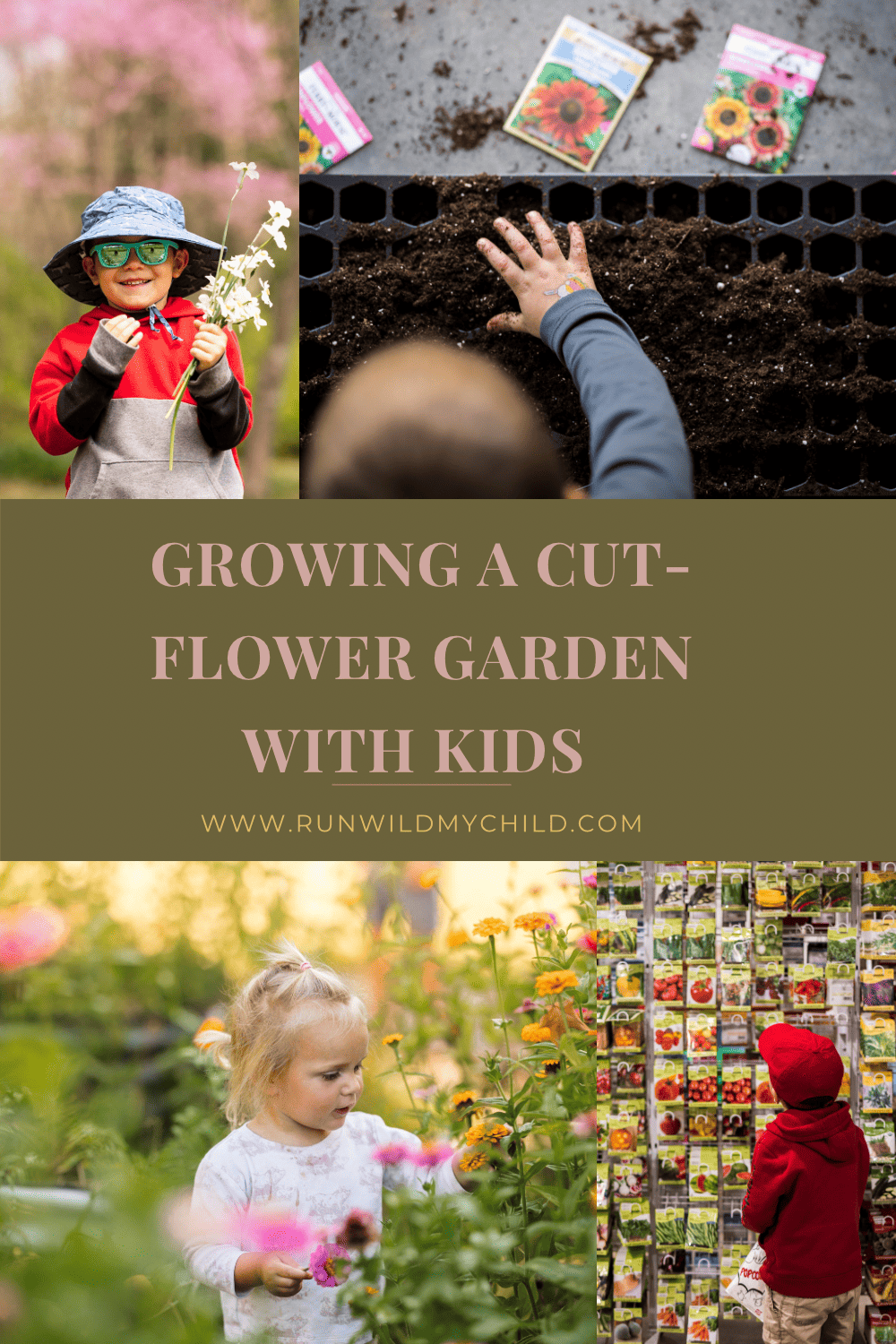
Growing a cut flower garden with kids
Starting and growing a cut flower garden is a relaxing and beautiful hobby. Involving children in the planning, growing, and harvesting of flowers can be a great learning and bonding experience. No matter your previous gardening experience, this post is designed to help you get started growing your own cut flower garden. I’m sharing some great plants to start off incorporating into your garden or yard, including a list of the easiest flowers to grow for kids and beginners.
What is a cut flower garden?
A cut flower garden is a garden specifically for flowers or foliage that will be harvested for fresh or dried bouquets and flower arrangements. The flowers are selected based on their bloom time, size, and color. Ideally, they have long stems and bright colors and maintain a long shelf life in a vase. Cut flowers can be annuals or perennials, flowers, filler plants, bushes, and foliage. Purposefully choosing a wide variety of flowers with differing bloom times will allow you to enjoy bouquets throughout the growing season, including spring, summer, and fall. These plants intended for cutting can be planted throughout your outdoor landscaping or in a separate area designated for cutting.
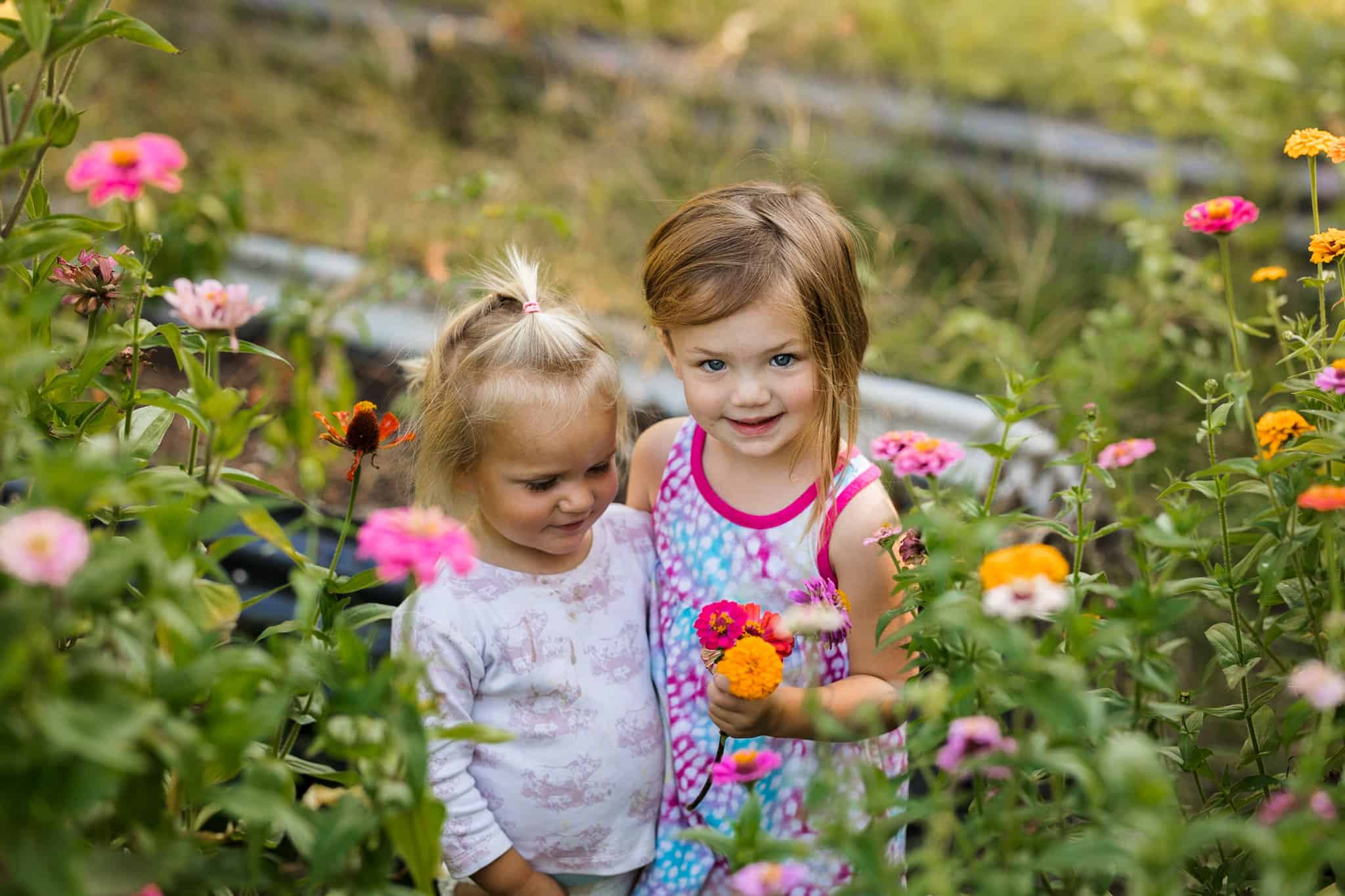
Benefits of growing a cut flower garden with kids
Growing a cut flower garden with kids can offer numerous benefits and educational opportunities. Here are a few benefits of growing a cut flower garden with your kids:
- Botanical knowledge: Kids can learn about various flowers, their life cycles, and the different parts of plants.
- Science skills: Observing the growth process teaches them about biology, ecology, and the importance of sunlight, water, and soil.
- Responsibility: Caring for the garden instills a sense of responsibility as kids learn to water, weed, and nurture the plants.
- Patience and delayed gratification: Waiting for flowers to bloom teaches patience and the reward of delayed gratification.
- Appreciation for nature: Kids develop a deeper appreciation for the environment and the beauty of nature.
- Environmental stewardship: Caring for plants helps instill a sense of environmental responsibility and stewardship.
- Creativity through floral arranging: Picking and arranging flowers encourages creativity and artistic expression and teaches art principles like color theory, lines, and textures.
- Sensory stimulation: Engaging with flowers provides a sensory-rich experience, from touching the petals to smelling the blooms.
- Tactile learning: Gardening involves hands-on activities that enhance tactile learning.
- Outdoor exercise: Gardening is a physical activity that encourages kids to spend time outdoors and get exercise in a natural setting.
- Sense of accomplishment: Watching their garden bloom gives children a sense of accomplishment and boosts their self-esteem.
- Stress reduction: Being in nature and tending to plants has been shown to reduce stress and promote overall well-being.
- Math and organizational skills: Involving kids in planning the garden layout and spacing of plants enhances their math and organizational skills.
- Culinary exploration: Some flowers are edible, and kids can explore using them in culinary activities, adding another dimension to their learning.
- Teamwork: Gardening can be a collaborative effort, promoting teamwork and social interaction among kids.
- Sharing and generosity: Kids can share the flowers they grow, teaching them about generosity and sharing with others.
Uses for a cut flower garden
Why should you grow a cut flower garden? The possibilities and reasons are endless!
First and foremost, the main reason most people grow flowers is because they are beautiful. Flowers not only make your garden and landscape more captivating and enticing but harvesting flowers from your garden allows you to create stunning and fresh floral arrangements to decorate your home. Handpicked flowers make thoughtful and personalized gifts for friends and family. Growing your own flowers can be cost-effective compared to purchasing floral bouquets regularly.
Flower gardens attract pollinators like bees and butterflies, contributing to the health of the local ecosystem. Growing your own flowers supports local and sustainable practices, reducing the environmental impact associated with commercially grown and transported flowers.
And, of course, gardening and working with flowers have therapeutic benefits, promoting relaxation and reducing stress. The act of nurturing plants and watching them bloom can positively impact mental well-being. Gardening and cultivating a cut flower garden can be a rewarding and enjoyable hobby, offering a connection to nature and a break from daily routines.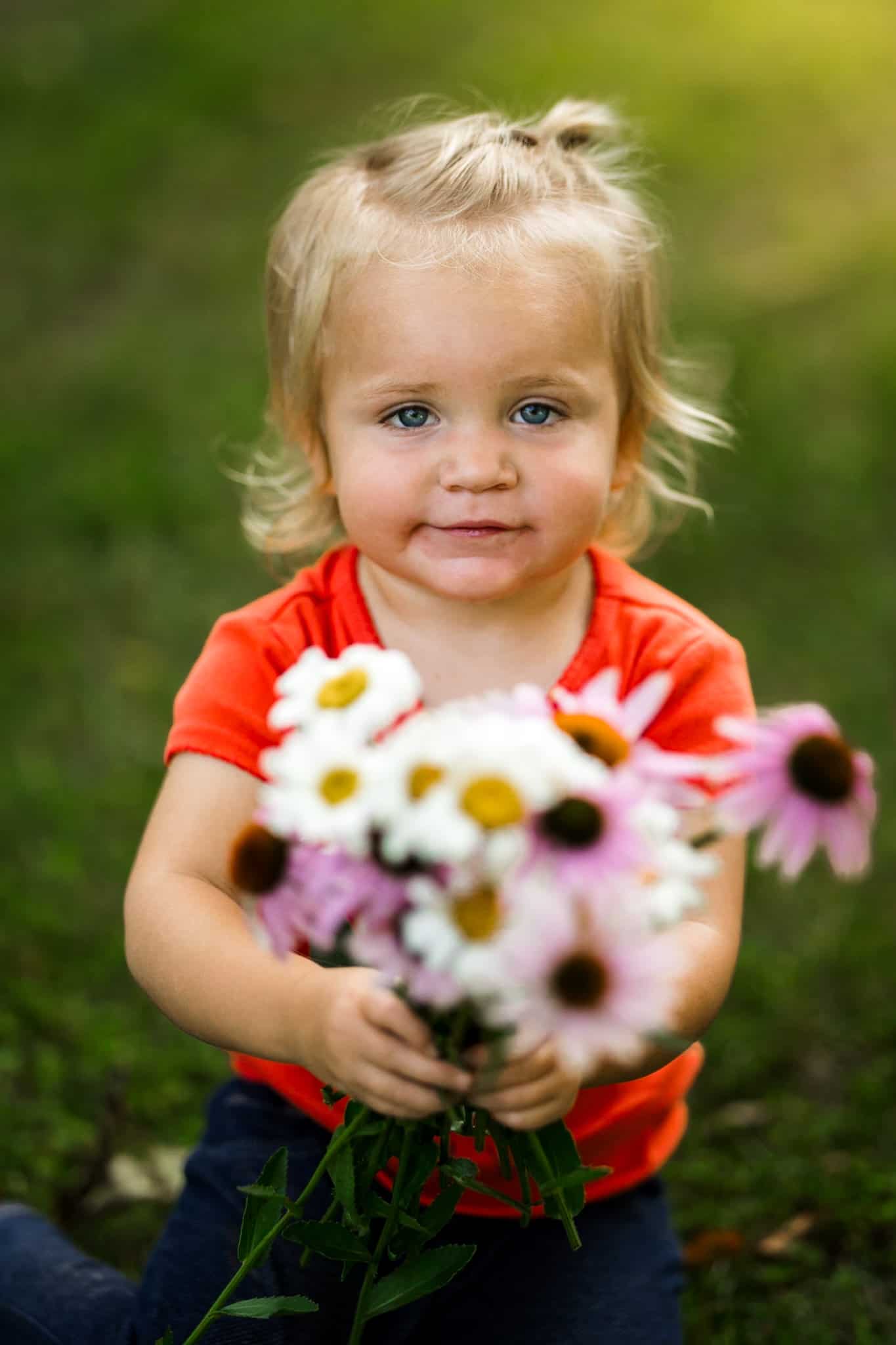
How to set up your cut flower garden
Before choosing your flowers, you’ll need to figure out where to plant them so your garden will flourish. There are a few factors that make for a great cut flower garden location: access to sunlight, protection from the wind, a well-drained area, and healthy soil.
Where to plant your cut garden
First, decide where you will be planting these flowers and foliage. Will you have a separate bed just for cut flowers, or will you space them out among your current landscaping? A cut flower garden doesn’t have to take up a lot of room. You can easily grow from the small pots on the porch, in a raised bed in the backyard, or on a sunny windowsill!
Find a location in your yard that receives adequate sunlight. Most flowers prefer full sun, so picking a spot that achieves 6-8 hours of sunlight per day is ideal. This will also satisfy any flowers that require partial sun. Be sure to check the back of the seed packets for sunlight requirements.
Also, consider wind and rain exposure. Lots of flowers grow fairly tall, and a strong wind can easily break them down. See if you can give them some protection from the elements if you live in a blustery or rainy environment.
It’s also important to find a well-drained area that won’t hold rainwater. Flowers don’t like to be kept overly moist, and too much water, especially standing water, will impede your flowers from growing and thriving.
Finally, a cut garden also needs fertile, workable soil (typically topsoil and compost). Obtaining a soil test will help you to determine what nutrients you might be missing in your soil, so you can add those missing nutrients back into the soil. Adding organic matter, including compost, leaf litter, and composted manure, will add nutrients to the soil and assist with proper water retention and drainage.
Creating flower beds
If you will be making new beds for your cut garden, it’s best to have long and narrow beds with room to walk in between. This way, you can reach all of the flowers for cutting. When gardening with children, you will want to make sure the flowers won’t be too high up for them to cut. So keep tall flowers on the ground and shorter flowers and raised beds.
I have my cut flowers planted on the ground around my raised garden beds. Many cut flowers are also deer-resistant, so last year, I planted them around my vegetable garden for a dual purpose!
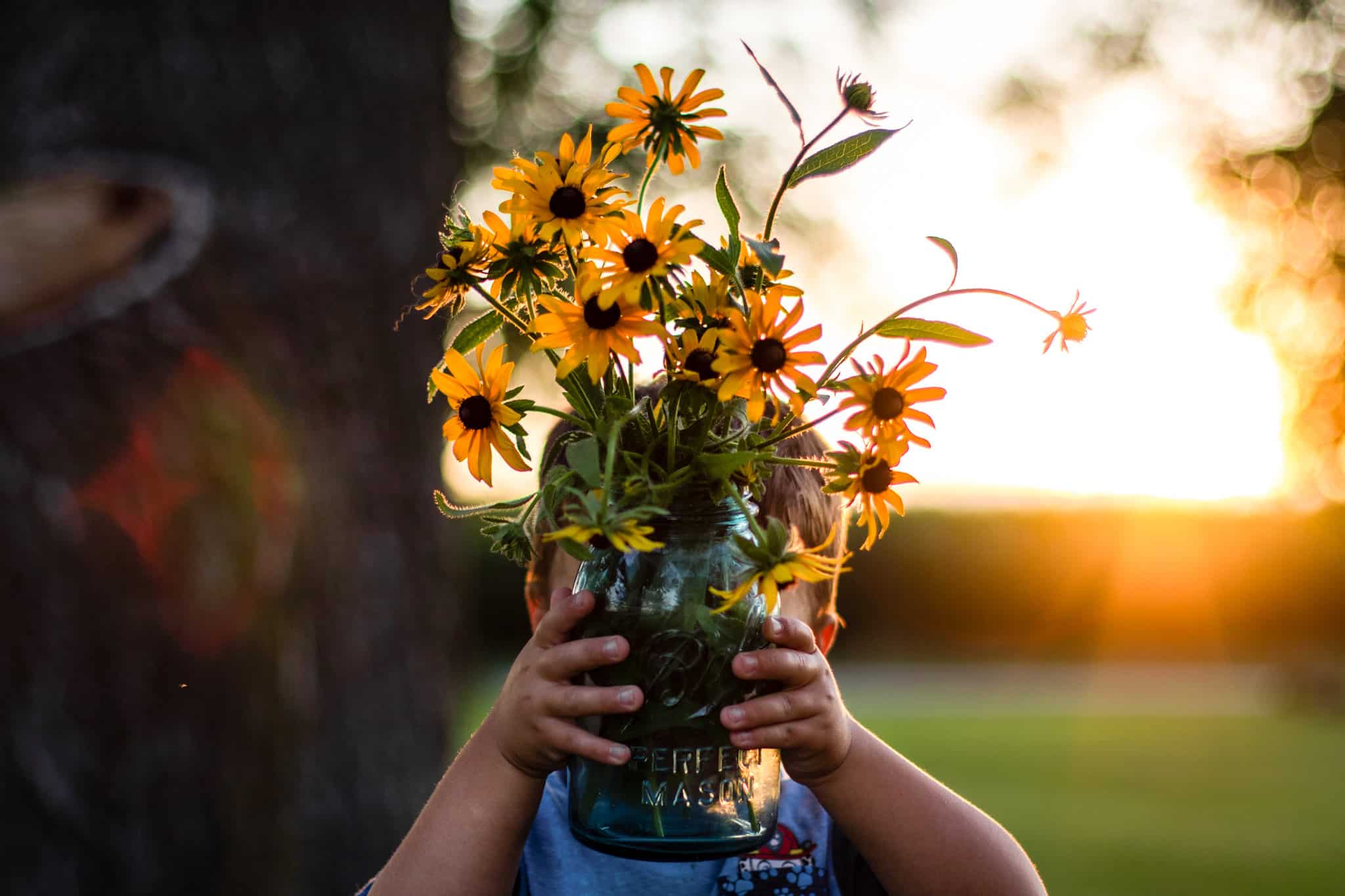
Easy, kid-friendly flowers to grow in your cut garden
There are so many different flowers and foliage that can be grown in a cut flower garden. When choosing flowers, consider a mix of colors, shapes, sizes, and textures. This will give you the most variety in your flower arrangements! Depending on what climate zone (find your hardiness zone here) you are in, you will have different plants that are appropriate for your area. When growing with kids, it’s best to choose flowers that are low-maintenance and have showy, colorful blooms to drool over.
Here are a few of my favorite flowers that can be grown almost anywhere with a little maintenance.
Annuals (needs planning every year)
Perennial plants and flowers (comes back each year)
- Black-eyed Susan’s
- Echinacea (cone glower)
- Yarrow
- Aster
- Daisies
- Hydrangeas
- Dahlias (perennial, depending on where you live)
- Tulips
- Peonies
Greens and fillers to grow in your cut garden
Fillers and foliage not only give contrast and texture to flower arrangements, but they can also offer beautiful scents! Here are some easy-to-grow greens and fillers!
- Bells of Ireland
- Green or purple Basil
- Mint
- Dill

Tips for choosing cut flower seeds and bulbs
Once you have decided where you will be planting, you will need to choose the right seeds or bulbs for that area. If you want your cut garden to produce across seasons, you’ll need to consider this when choosing your flowers. Bulbs will have to be planted in the fall for spring blooms. Seeds can be planted in the spring for summer and fall blooms.
In order to get the most out of your garden for the longest time, I suggest picking different varieties of spring and summer flowers for each location. An example would be planting tulips or daffodils in the same area as Black-eyed Susans and purple coneflowers. Since these flowers grow in different seasons, they will not be competing with each other for nutrients, but they’ll maximize the number of flowers you can get out of one location.
Another thing to consider when choosing your seeds is germination time. Germination time is the time it takes for the seed to begin to sprout. Seeds that have a long germination time will be more difficult to grow and will need to be started indoors if you live in a cooler climate. Flowers like sunflowers and zinnias usually germinate in a week or so, which makes them ideal for anxious kids who are ready to see their flowers growing.
Where to find flower seeds, plants, and bulbs
There are lots of places you can get seeds, bulbs, plants, tubers, and transplants. For starters, check with your local nurseries or garden centers. This way you can see the flowers in person and ask any questions to the knowledgeable staff. In addition, starting in early spring, you should be able to find seed packets at your local hardware store, grocery store, farmer’s markets, or even the dollar store! Get the kids involved in this process and let them choose a flower, plant, or seed packet.

Planting seeds indoors
If you are itching to get the garden started, there are many options for starting your flowers indoors. This is also a fun way to get kids excited about spring and working in the garden. Most seeds will tell you on the back of their packet when to start indoors. Some seed flowers prefer to be sowed directly in the ground, so those will have to wait to be planted until after the danger of frost.
To start seeds inside, you will need:
- Seed starting soil
- Seed starting cells and trays
- light source (window or grow lights)
- warm area
Tips for starting seeds inside
To begin, mix some water with your seed-starting soil. The soil should be damp but not soupy. Fill the cells or pots with the mixture. Read the package for the desired planting depth. Make a small space in the middle of the pot or cell and plant the seed at the correct depth. Make sure you label what you have planted!
Place your newly planted seeds in a warm place with plenty of natural light or under a grow light. You will want to keep the seed nice and damp while waiting for germination! You can use a fan blowing on your seed tray to mimic wind, which can help the stalks grow stronger.
For bigger seeds like sunflowers, it can be fun to fold them into a damp paper towel and place them in a plastic bag and a warm area. This way, you can watch the seeds begin to sprout. After they sprout, plant them at the desired depth in a small pot or cell.
Once your seeds have sprouted and you’re out of the danger of frost, you can begin to move your sprouts outside. It is a good idea to put your trays of seeds/seedlings outside for a few hours on warm days to help them get acclimated to the wind, bright sun, and outdoor temperatures before planting. A few hours a day is a good start.
Planting bulbs outdoors
Bulb planting typically happens in the fall before the first frost. Each plant will have a specific planting depth and spacing, so be sure to follow the directions for that plant. Planting bulbs in the fall will help your garden span more seasons, as these plants usually come up in the spring prior to the last frost. This gives you fresh flowers sooner!
Here are some easy bulbs that grow flowers great for cutting:
- Tulips
- Daffodil
- Hyacinth
- Hosta
- Iris
- Crocus
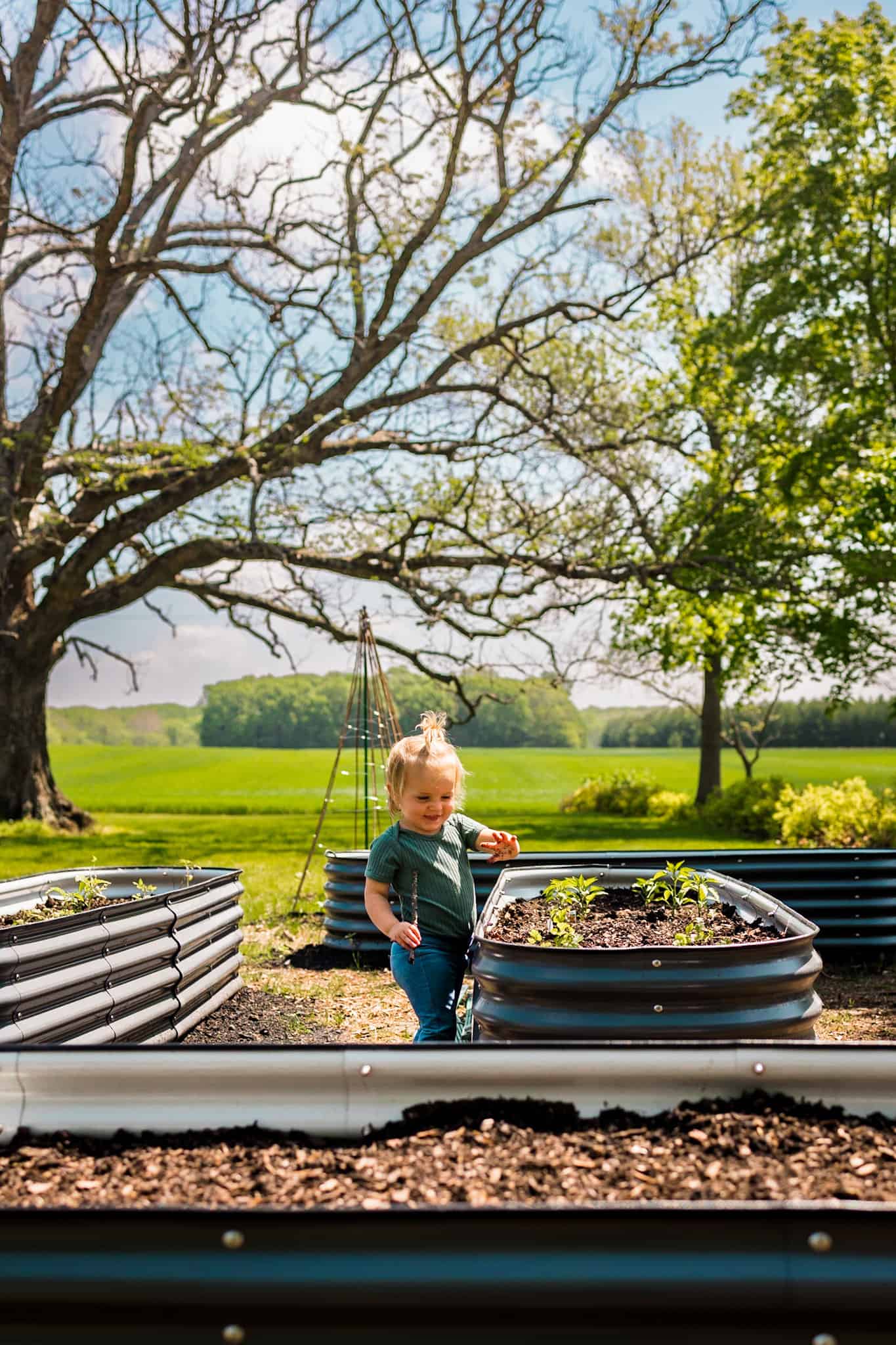
Planting seeds outdoors
Seed planting typically happens in the spring after the danger of the last frost. For perennials, you will only have to plant one time, and then they will come up each year. For annuals, you will have to plant them again each year. Although, there are some annuals that will re-seed themselves.
Before planting your seeds, make sure the ground is raked and loose so the seeds can enter the soil. If you are planting in a small space or between other landscaping, be sure to give your seeds enough room for their full height and width. If you are planting in a large area, spreading the seeds around by hand can be a great task for your child.
Once the seeds have been planted, be sure to keep the ground damp for a few weeks to help the seeds germinate. You may have to watch out for squirrels and chipmunks, who love to feed on sunflower seedlings!
Transplanting seedlings outdoors
Transplanting your seedlings (that you started indoors) outdoors will also happen after the danger of the last frost. It is a good idea to put your seedlings outside for a few hours each day before transplanting outside. That way, they can get acclimated to temperatures and wind.
To transplant your seedlings, gently take the entire root bundle from its cell. And make your hole a little deeper than the depth of the cell. Put your root bundle in the hole and cover it completely. Again, make sure to keep the soil moist for the first couple of weeks after transplanting.
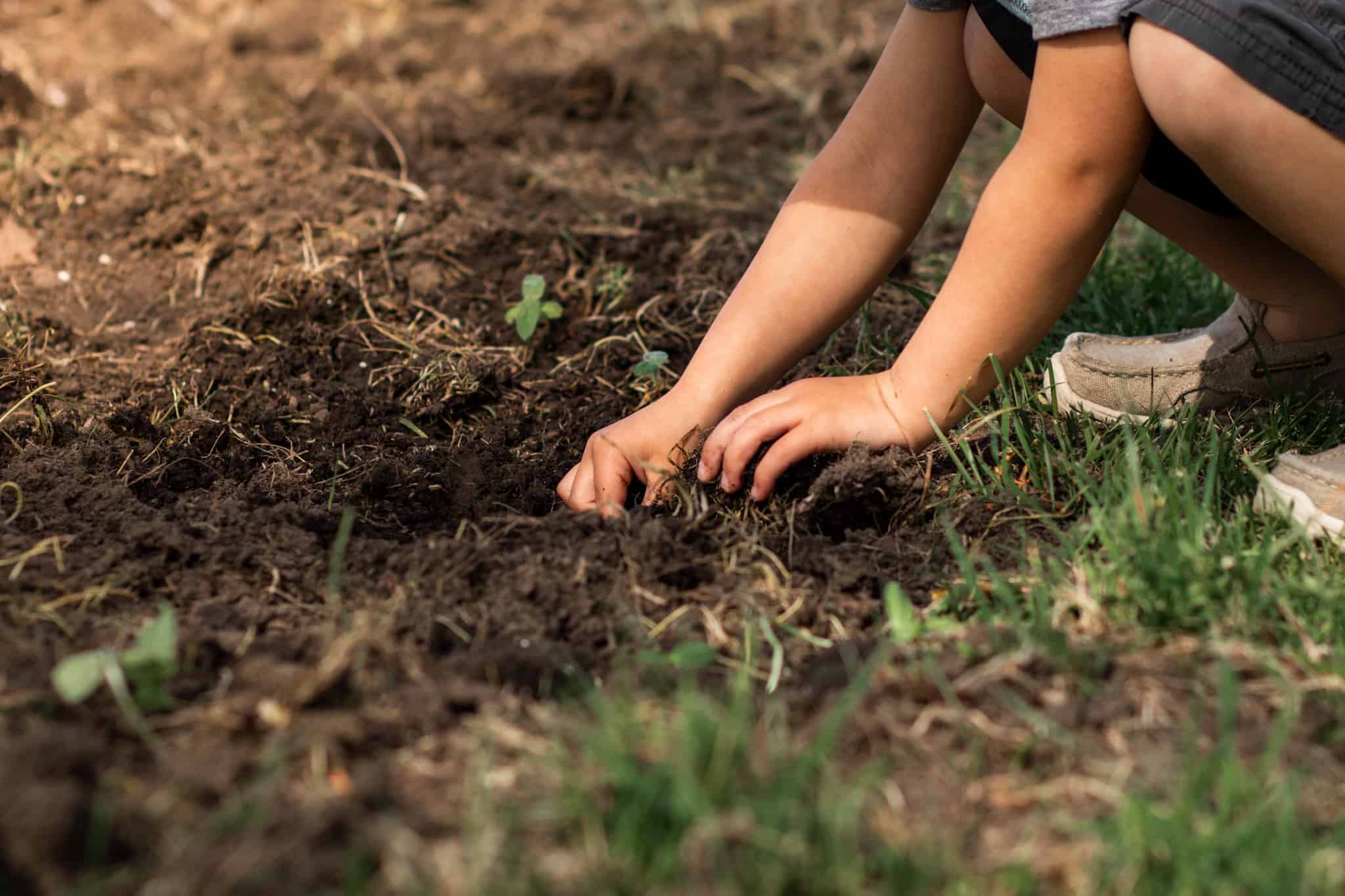
Caring for your cut flower garden
Between planting your garden and harvesting flowers, you’ll need to care for and maintain your cut flower garden. It will be important to keep the weeds or grass from growing around your growing flowers. Weeding is a great task for kids; just make sure they know what is a weed and what is a flower! Weeding can be done as often as every day or as little as once a week, depending on where your garden is located.
It will also be important to monitor how much rain your garden is getting. If you go more than a few days without rain, it’s a good idea to water them. It is best to water early in the morning or late in the evening. Again, watering the flowers is a great task for kids. Kids love using the garden hose; just be sure to show them how to water the plants properly (not too hard of spray) and not too much.
You may also want to fertilize your flowers twice a month with a well-balanced fertilizer.
Some flowers may need support, such as staking, netting, or corralling. For simple purposes at home, I would suggest using bamboo stakes and plant velcro to help support your flowers upright to get straighter stems.
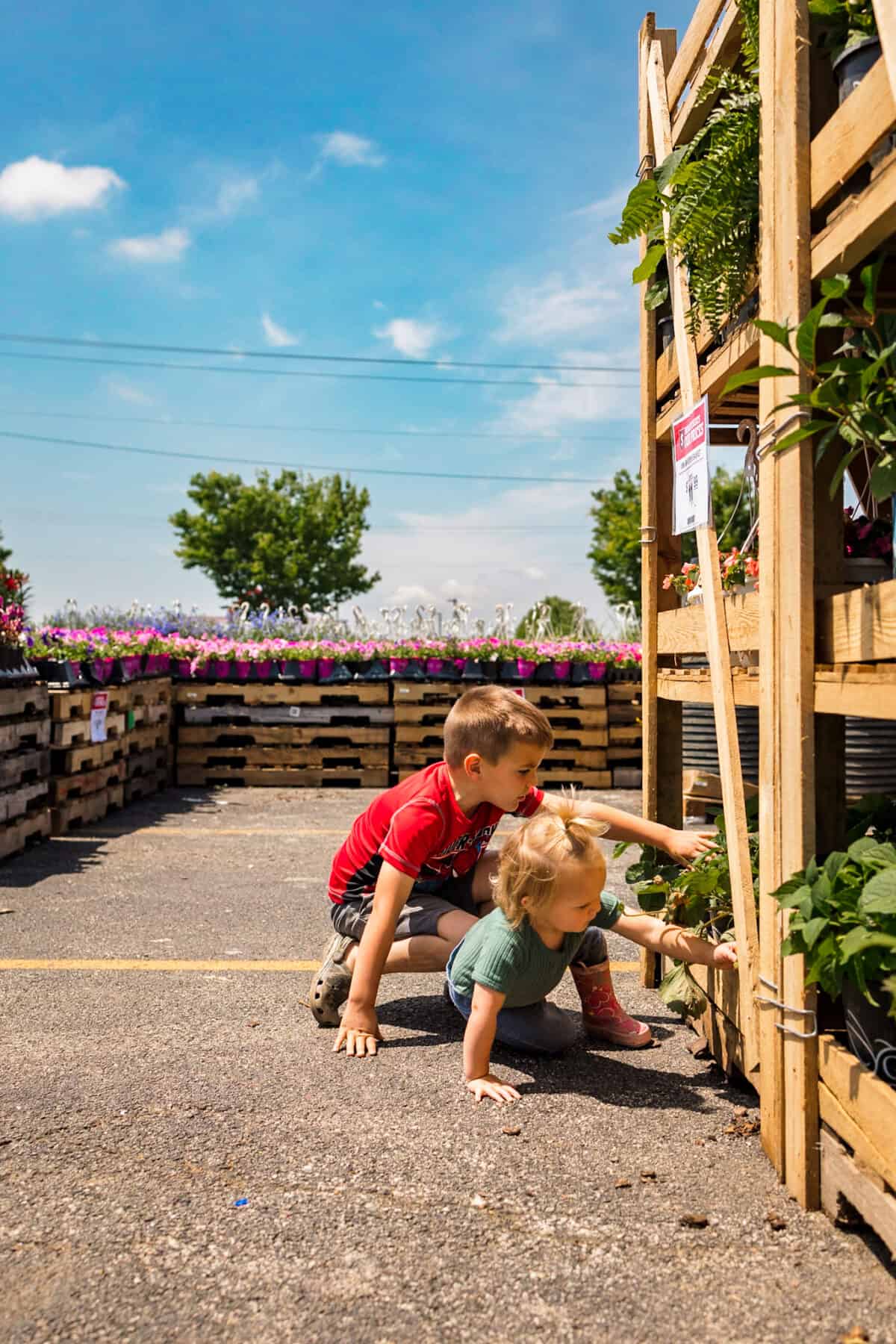
How to make gardening fun for kids
There are so many ways to get the kids involved in the gardening process and make it fun for them. When planning your cut flower garden, be sure to involve kids in the seed-choosing process. Ask them to choose their favorite color flower, or let them pick a seed packet to plant. A specific color flower for each kid would be fun if you have multiple kids.
Get them involved in the maintenance process, too! It’s more fun when you dress the part, right? Getting some kid-size gardening gloves, a fun apron, and maybe a bucket hat can help kids look and feel ready to help! Smaller tools like shovels, mini rakes, and small watering cans will make it easier for them to assist in all the different ways we care for the garden!
And finally, make sure they get to help harvest the flowers and enjoy the fruit of their labor by helping make flower arrangements and bouquets. Before cutting, talk to your child about what colors or textures they want in the flower arrangement! Let them be the boss for choosing the flowers, and let the adult do the cutting until it’s appropriate for the child to use shears.
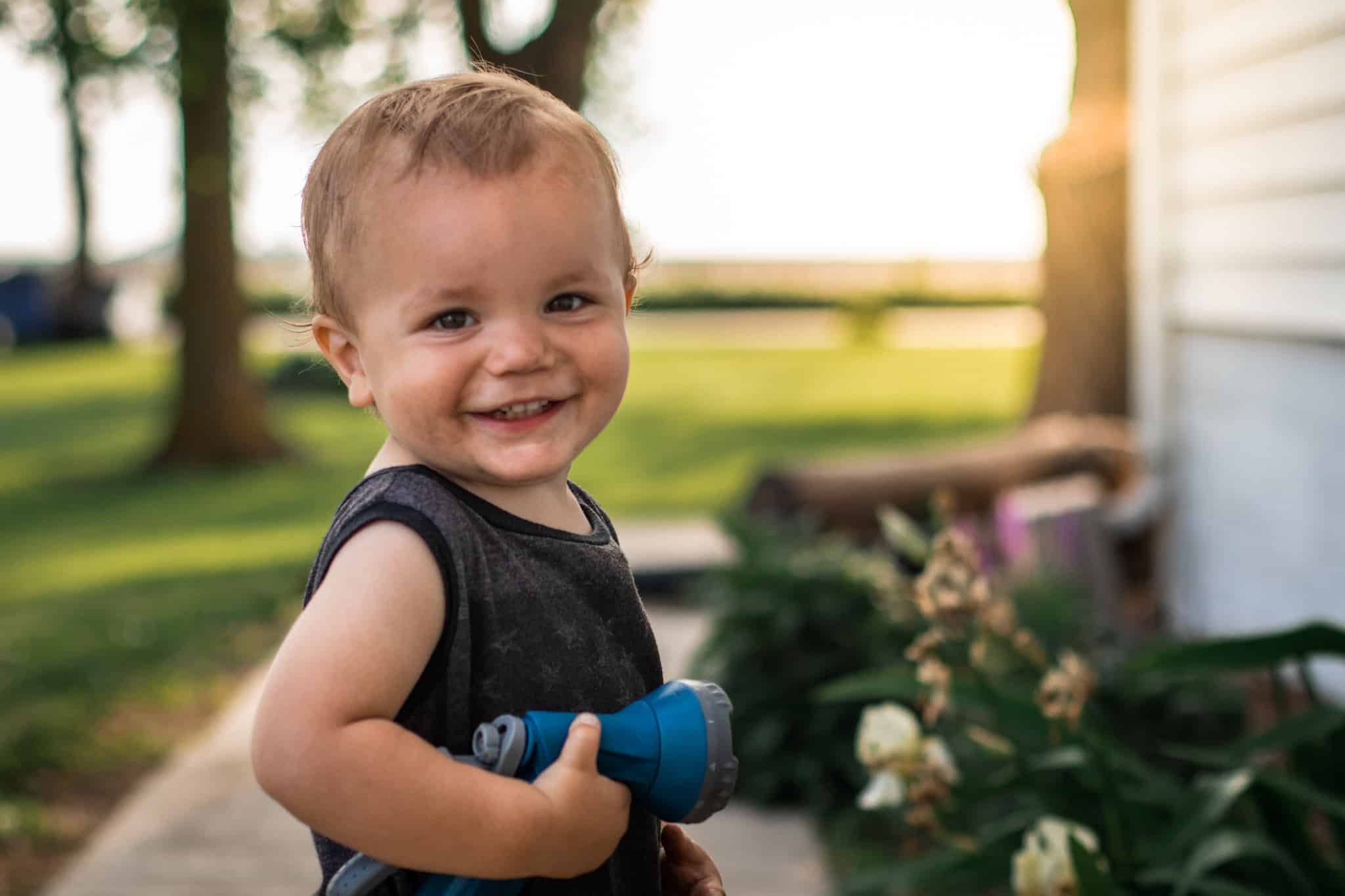
Harvesting flowers with kids
Now, we’re ready for the good part…harvesting the flowers!
For many cut flowers, the more you cut, the more they will bloom. This is definitely the case with cosmos and zinnias! So don’t be afraid to get in there and start cutting when blooming begins. Just be sure to leave enough of the plant so that other buds can grow.
However, some plants are a “one-hit wonder” and will only bloom once. Plants, such as single-stemmed sunflowers and tulips, only produce one flower and then are done. The one-hit wonders you will want to plant more of so that you have more blooms, and you may want to consider succession sowing them.
The best time to cut flowers is at the beginning of bloom or right at peak bloom. When going to cut flowers, it’s a good idea to know what size vase you are going to put them in. That way, you know how long of a stem to cut.
Using garden shears, cut at a 45° angle, this will allow the stem to get, the most water once in the vase. Harvest cut flowers when it is cool outside, either early in the morning or later in the evening. Place your flowers immediately in a bucket/vase of cool water and let them sit at least a few hours before you work with them. You may want to check the flower for her bugs and spiders before bringing it into the home!
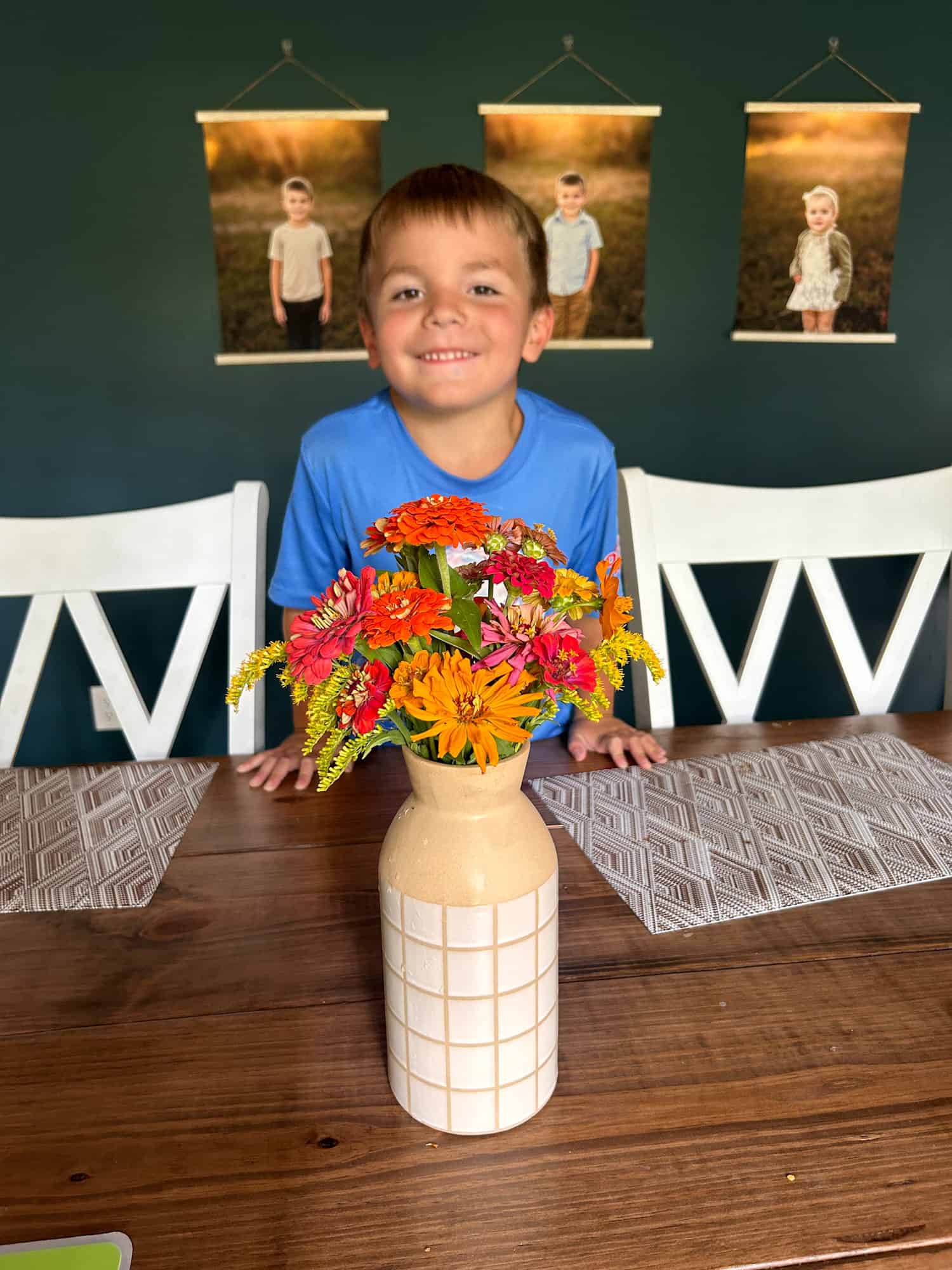
How to make your cut flowers last longer
Once you’ve harvested your cut flowers from the garden, it’s time to arrange them. Here are simple steps to help extend the life of your flower bouquet:
- Remove all the leaves off the bottom of the stem (the part that will be submerged in water) to keep them from rotting underwater.
- Cut the stems at an angle to allow for greater water absorption.
- Add some cut flower food into the vase of water.
- Change the water daily or when it becomes murky (don’t just add more water).
- When changing the water, re-cut the ends of the stems at an angle and add more flower food.
- Remove any flowers or leaves that are dead or dying.
- As you remove dead blooms, downsize to a smaller vase when your bouquet gets smaller.
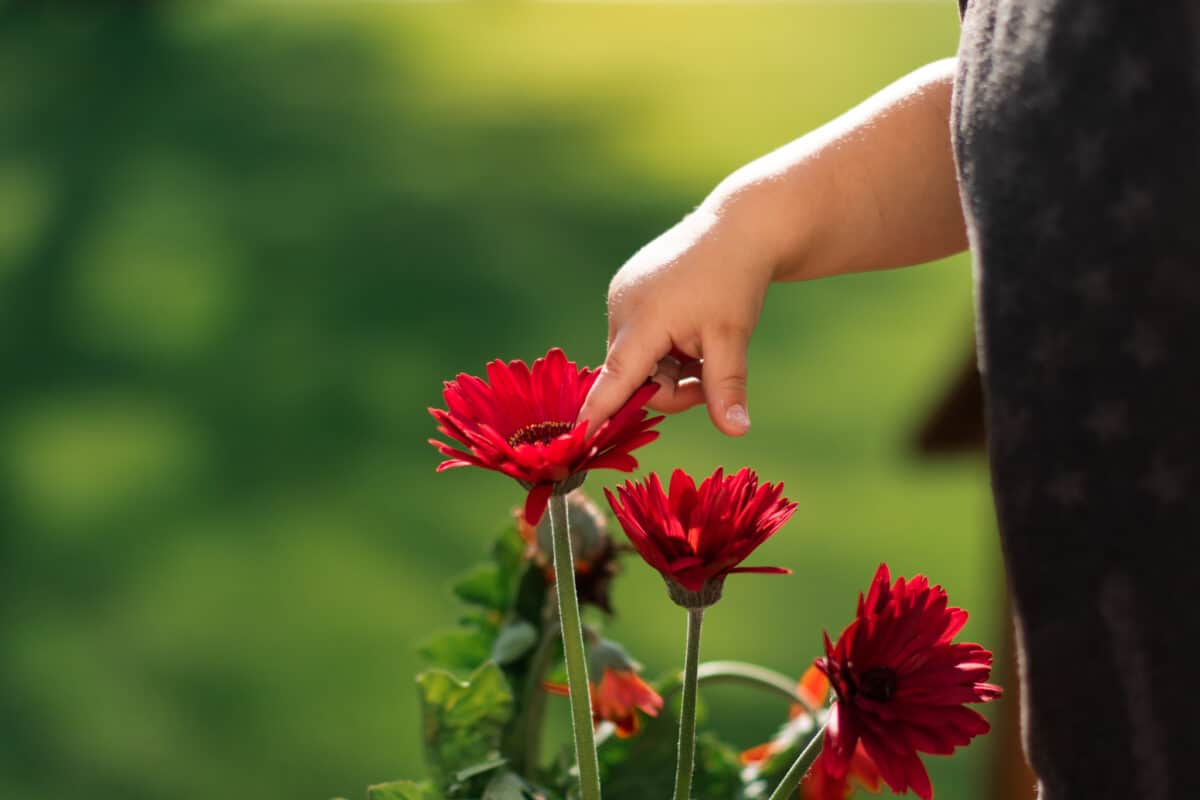
Creating cut flower arrangements with kids
There are five design elements to keep in mind when it comes to arranging flowers. These elements are line, color, form, space, and texture. Depending on your child’s age, you may pick anywhere from one or all of these elements to focus on when designing your arrangement.
To start, I would focus on color and texture. These flower bouquets, based on color, will be the easiest for children to identify. When choosing colors for your arrangement, think of choosing complementary colors or analogous colors. Complementary colors are opposites on the color wheel, like yellow and purple, or red and green. Analogous colors are colors close together on the color wheel (e.g. yellow, peach, and orange).
When thinking about texture, try to have the child choose flowers with different petals, sizes, and shapes. Flowers with large petals (like zinnia and peonies), tend to be a more softer texture. Flowers with small, round, or frilly petals, like aster or yarrow, tend to give a contrasting texture.
When putting arrangements together, start small with just one or two different flowers, keeping their leaves for fill and contrast. As you get better at designing, you can snip the leaves off the stem so you only have the flowers and then choose your own filler flowers and foliage that add to your arrangement’s overall theme. To learn more about floral design, I loved the book Love Language Of Flowers.
Something fun I do with my kids after creating an arrangement is naming it. We usually name our arrangement of beautiful blooms based on its colors. A few examples are Sunset, this arrangement was full of bold magenta, yellows, and oranges like a sunset. Another flower bouquet example is one named Just Peachy; this one was full of peachy colors and lacy floral accents! The best thing about flower arranging is that you can do it however you want!
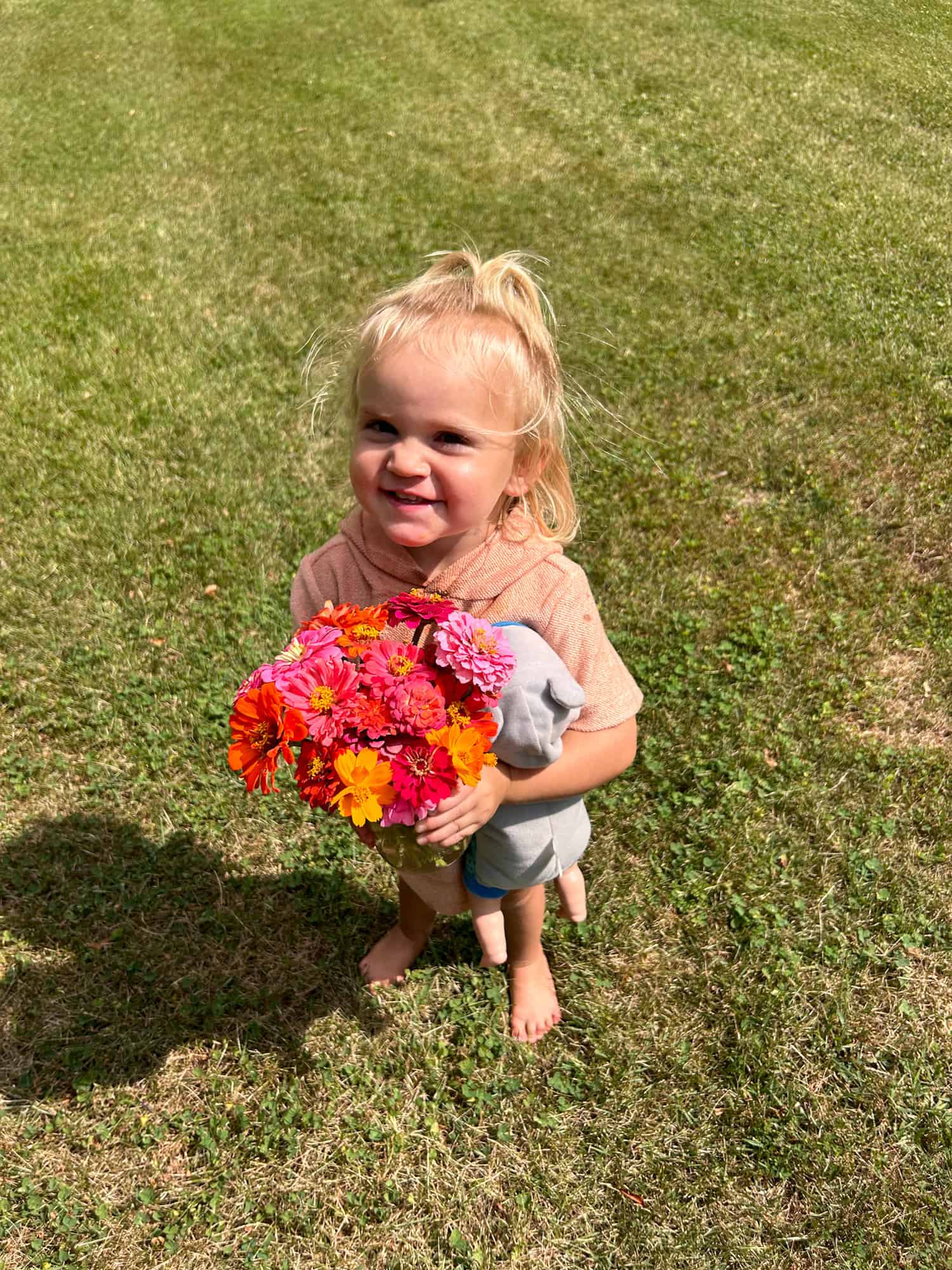
Sharing the love of flowers
Once your garden is producing a lot of flowers, you may have enough for multiple arrangements or bouquets. Have your child pick a person to gift an arrangement to and let them do all the work of making it and delivering it. Not only does this teach your child the importance of giving and sharing, but it will likely make somebody else’s day! Your child will have such a sense of pride when they see how happy their gift has made someone else! In addition to giving flowers to people you know, donating flower arrangements to local nursing homes and community centers can help children feel a sense of accomplishment for all their hard work!

Drying and pressing flowers
Live flower arrangements are not the only way you can enjoy your flowers. Drying and pressing flowers are a great way to enjoy and preserve your flowers. Flowers like daisies and pansies lend themselves to be easily pressed. Plants like strawflower, lavender, and Celosia can make beautiful dried arrangements that can be enjoyed all year long! You can even use pressed flowers to make a fun Halloween costume, like pressed flower butterfly wings.
Saving and collecting seeds
Once the blooming season is over, there is still work that can be done in the garden. Flowers like zinnia and cosmos are very easy to collect seeds from to save for the next year. Collecting seeds is not only an easy job for kids, but it is a great way to prepare for next year and save money. We collect seeds in paper sandwich bags and label them with the type of flower they are. We store these bags in a cool, dry place until next year. Seeds collected from your own garden are also a great gift to give to others!
Sustainability and recycling
It is important to teach sustainable practices for your cut flower garden. Saving seeds is a great start! Using reusable starter trays instead of plastic ones can also cut down on plastic waste. Used spaghetti jars, glass juice containers, and old mason jars can make great vases for arrangements. When you save these items, not only are you repurposing and recycling, but you have more vases to give away without spending money!
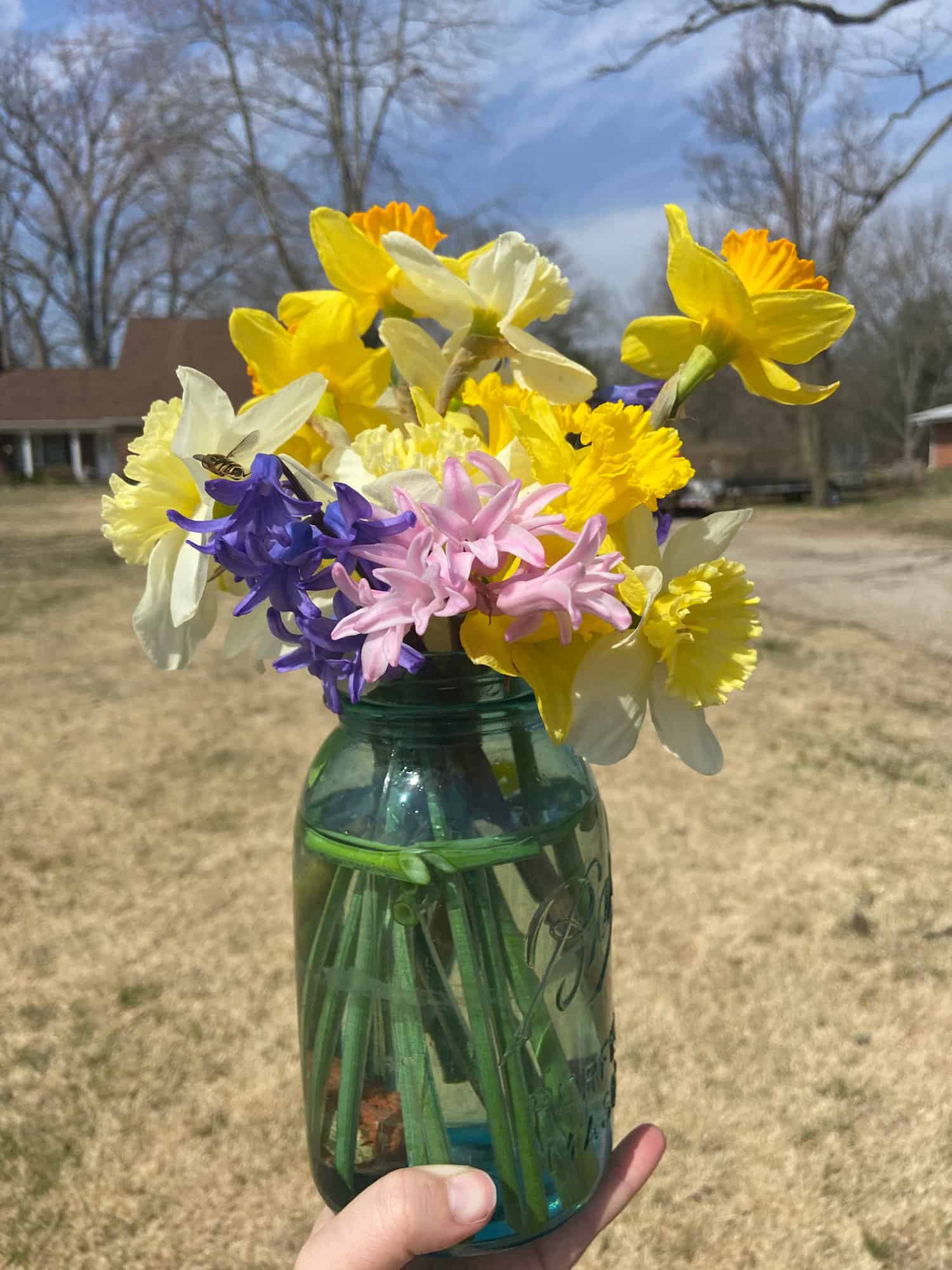
Learning while you grow
Creating a cut flower garden with your children is such a great way to teach science, math, and art skills. The time spent with your children in the garden will increase their confidence and give them a sense of responsibility. Plus, the flower arrangements you create will bring daily joy. It may be difficult getting started this first time, but it’s worth it. And every year, you and your children will learn and grow as people and as gardeners. Each year will be more bountiful, joyful, and meaningful. Good luck with starting your own cut flower garden this year!
Do you grow cut flowers in your garden?
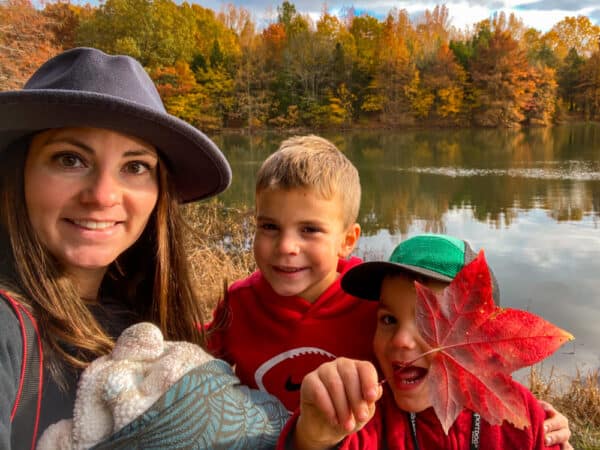
About the author
Meghan is a midwestern mom of 3 kids and one dog. She is a physical therapist assistant and family photographer. At home, Meghan and her family enjoy gardening (both indoors and outside), riding ATVs, and exploring the river behind their house. When not at home, they can usually be found at the lake or exploring Illinois state parks. Meghan’s family has always loved the outdoors, but they really found a passion for being outside and photography when her oldest son had to undergo a bone marrow transplant as a baby. During her son’s recovery, being outside became a safe place for the whole family to learn, grow, and thrive.
You can find more from Meghan online in the following locations:
Instagram: @meghangarriott
Meghan’s RWMC posts: Meghan Garriott

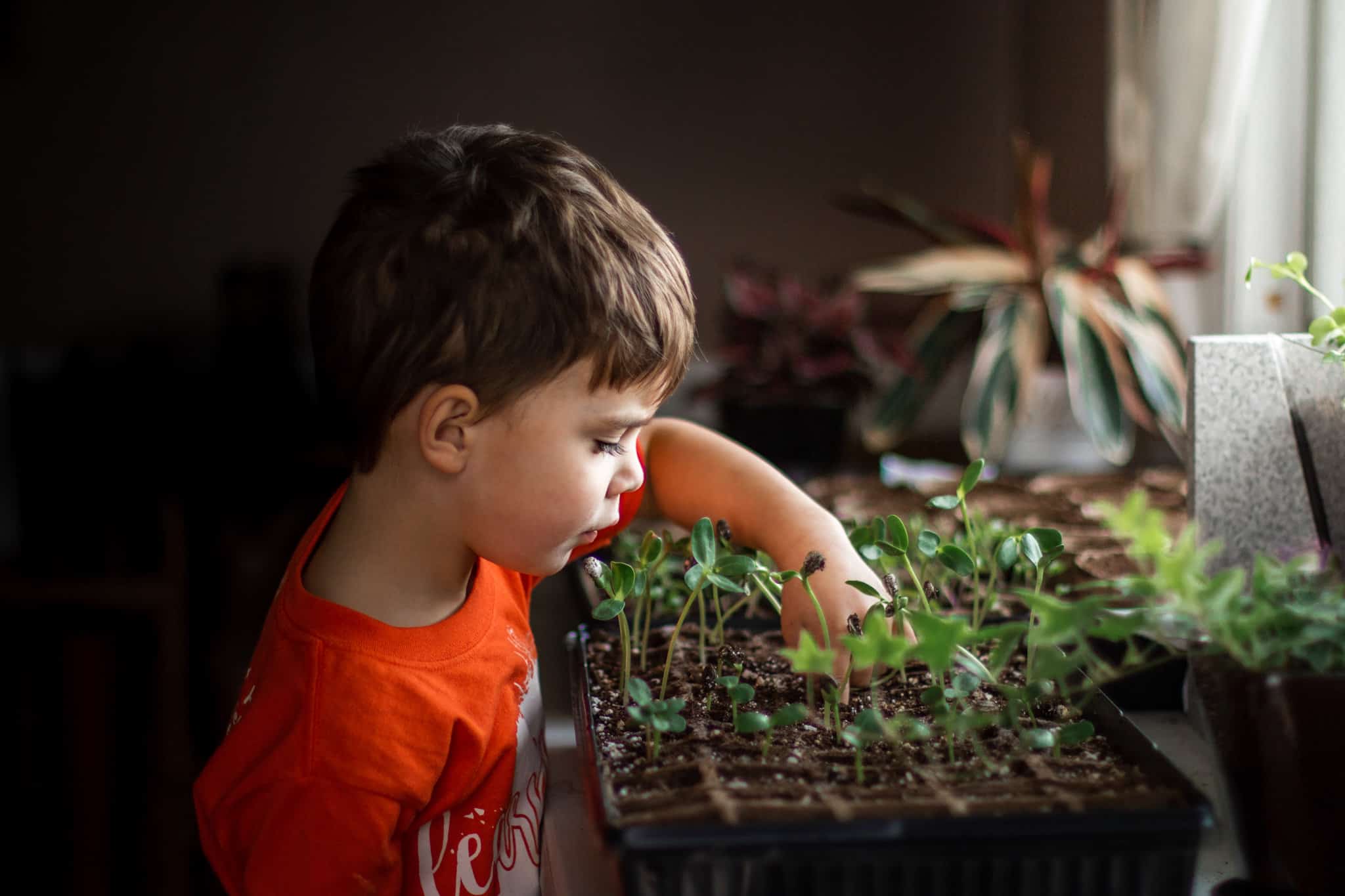
Leave a Reply